1962 Belgian Grand Prix race report: A fine win for Lotus
After an initial five-way scrap, Lotus driver Jim Clark streaks away to take debut win ahead of Graham Hill and Phil Hill
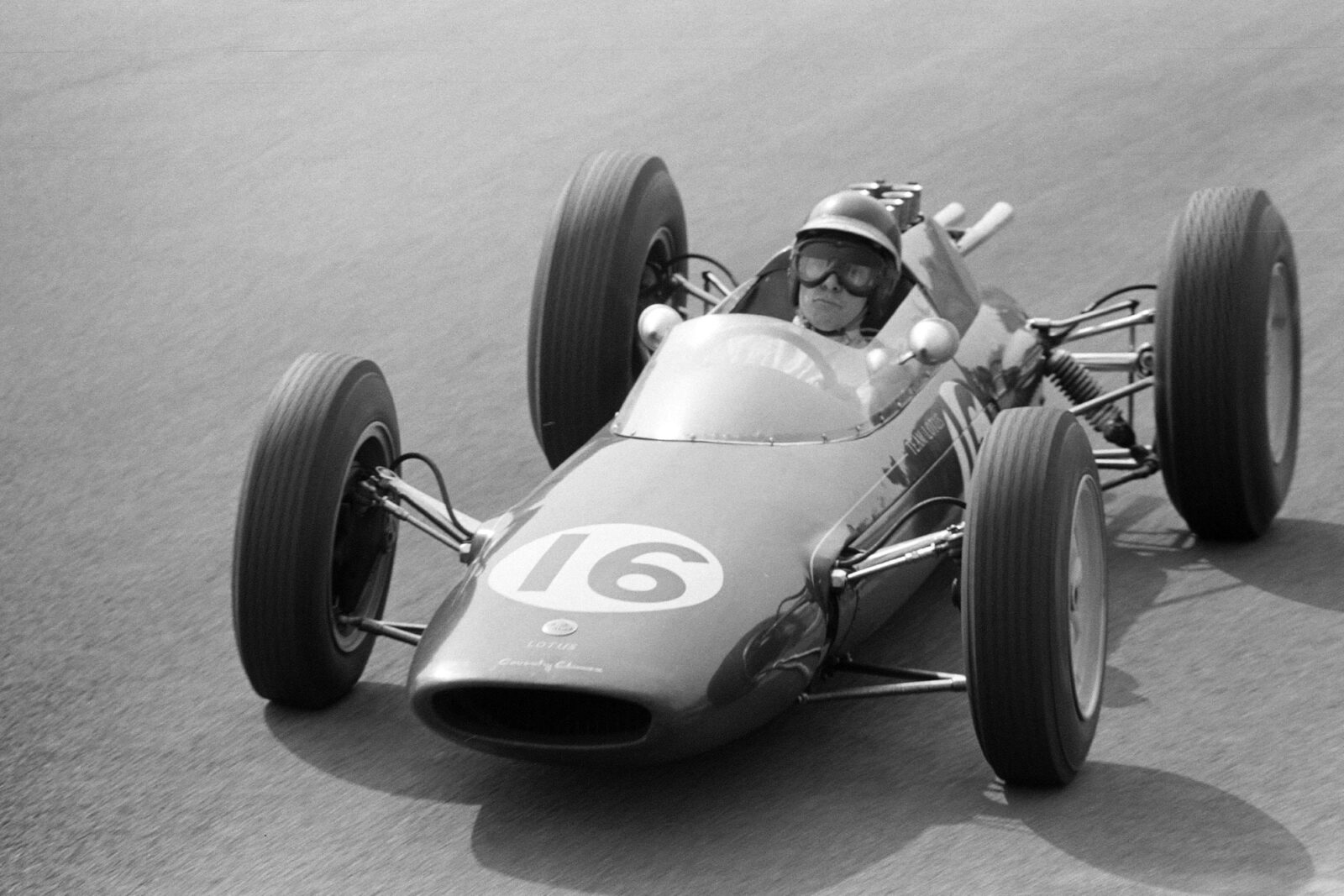
Jim Clark took his debut win in the Lotus 25
Motorsport Images
The wonderful 14.1-kilometre circuit that runs between Francorchamps, Malmedy and Stavelot, in the hills near Spa, needs little introduction to followers of Grand Prix racing, and this year everyone was looking forward to the Belgian GP with keen anticipation as it was to be the first time that the new British Grand Prix V8 engines could be wound up to full song in top gear and kept there for a considerable time.
On paper the grid was to consist of sixteen invited drivers and those others who would qualify from the remainder of the entry. As it turned out a number of people did not arrive so there was no need for any qualifying, among those who did not appear being the two works Porsches, internal strife at the factory still holding up their active racing programme, the two private BRM owners, Lewis and Marsh, did not come, and Bowmaker entered only one Lola.
The Scuderia Ferrari were out in force, having four 120-degree engined cars for Hill, Mairesse, Baghetti and Rodriguez, it being Bandini’s turn to sit in the pits and watch. Three of the cars had new front wishbones with easily adjustable base pivots, and all had the wider rear wishbones, while only Rodriguez was using a rear roll-bar. They were virtually as last year, the new chassis with forward-mounted gearbox not being used, nor was there any sign of the new “4-valve” cylinder heads.
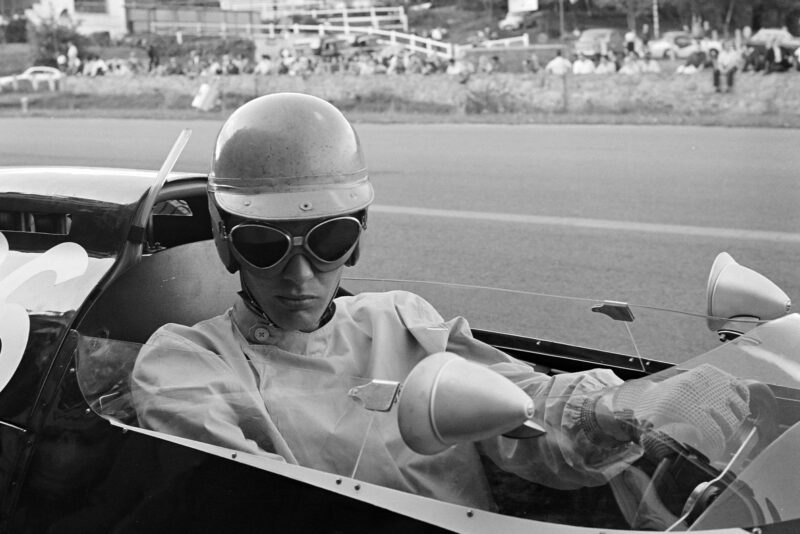
Tony Maggs prepares to head out
Motorsport Images
The two works BRMs were as we had seen in practice for Monaco, with G Hill in his usual car, with new engine after the monumental blow-up, but with low-level exhaust system now, and Ginther had the new car with 6-speed Colotti gearbox and a redesigned bell-housing since Monaco. Team Lotus drivers Clark and Taylor were in their usual cars, both with Coventry-Climax V8 engines, the former with the new carburetter layout and the latter with the old layout. Clark had the sleek “monocoque” chassis car and much was expected of it on this fast circuit.
After their win at Monaco the Cooper team finished off their second Coventry-Climax V8-engined car with 6-speed Cooper gearbox, sure in the knowledge that there wasn’t much wrong with the car, and Maggs was using this brand new car. The Bowmaker team were running only one Lola-Climax V8, once more fitted with its long sleek nose cowling, and Surtees was the driver, fresh from his Mallory Park 2,000-guineas win, and UDT-Laystall had their two Lotus 24 cars, the Coventry-Climax V8-engined one for Ireland and the BRM V8-engined one for Gregory, they too having had a Whit-Monday victory to boost their morale.
The Rob Walker team had completely rebuilt the Coventry-Climax V8-engined Lotus 24 crashed at Monaco, needing a new chassis frame and all new suspension, and once more Trintignant was the driver, while their old 4-cylinder Lotus, that G Hill had driven at Mallory Park, was on loan to Bianchi and the Equipe National Belge. To complete the list there was Brabham with his bright green Lotus-Climax V8, Siffert with his Lotus-Climax 4-cylinder, Campbell-Jones with the works Emeryson-Climax 4-cylinder and Beaufort with his private Porsche 4-cylinder. At the last moment the Seidel team entered a Lotus-BRM V8 for Gurney to drive, this being borrowed from Team Lotus; of Bonnier there was no sign.
Qualifying
Practice began on Friday evening in warm and dry conditions and bogey time was obviously a 4min lap, for last year Phil Hill had done 3min 59.3sec in a Ferrari in practice and in the race Ginther (Ferrari) had done 3min 59.8sec. The circuit lap record is still held by Brabham with a 2.5-litre Cooper-Climax at 3min 51.9sec, set up in the 1960 race, while in practice that year he recorded 3min 50.0sec, but only race times count for records.
Phil Hill was first away when the circuit was opened for practice, but Clark was not far behind and neither was McLaren, so that it was obvious that they all meant business. The BRM team were not their usual confident selves to begin with, both cars needing attention after only a very brief run, Hill having his brakes bled and Ginther having trouble in the fuel lines.
“Really high-speed practice laps seemed to be lacking and trouble seemed rife, Ginther’s BRM spewing out oil and Clark’s Coventry-Climax V8 damaging itself”
It was Trevor Taylor’s first visit to Spa-Francorchamps and he was settling in nicely, soon down to 4min 10sec, while Maggs was having his first go in a V8 Cooper, but he did not get far before he came to rest with no ignition and mechanics had to go out and rescue him. Surtees was also in trouble for his V8 Coventry-Climax engine tightened up on him and he parked the Lola at Stavelot before bits came out of the side of the crankcase, getting a lift back to the pits on the tail of Ireland’s Lotus. The two UDT-Laystall cars were going all right but the drivers were not too convinced about the handling at high speed, but even so Gregory sorted-out McLaren in the works Cooper on one lap.
Really high-speed practice laps seemed to be lacking and trouble seemed rife, Ginther’s BRM spewing out oil and Clark’s Coventry-Climax V8 damaging itself when a dowel in the camshaft driving mechanism sheared. It was Mairesse who began to set the pace when he went round in 4min 03.5sec, to which Graham Hill replied with 4min 03.0sec but he did not look at all happy when he stopped at his pit. Ferraris now began to get down to it, Phil Hill doing 4min 03.6sec and Mairesse 4min 03.3sec.
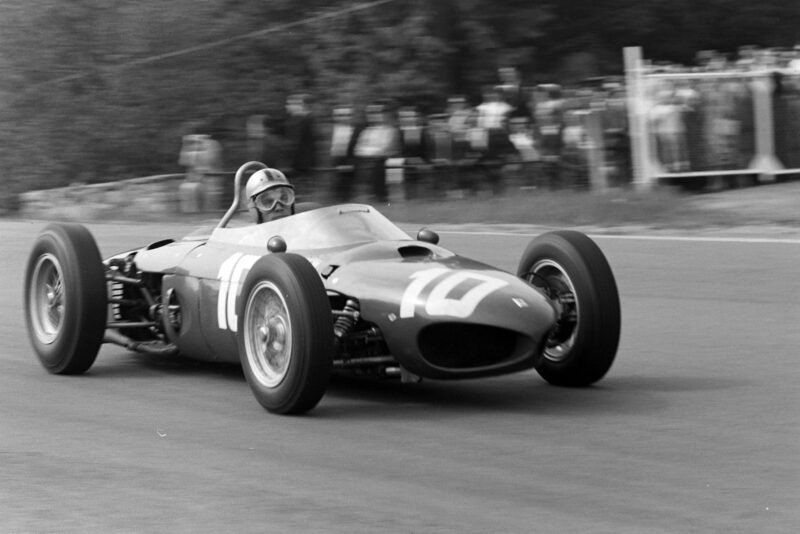
Ferrari removed the perspex covers off its engine and brake-cooling ducts in a bid to reduce drag, as seen on Mairesse’s car above
Motorsport Images
Everyone was convinced that their engines were not breathing properly at high speed, and Ferraris removed the Perspex covers over the carburetters and also took off the Perspex brake-cooling scoops to reduce drag. Phil Hill just had to break the 4min barrier, having done so last year, but admittedly the billiard-table surface of the Masta straight is now wavy and bumpy after a hard winter, but for a change the Ferrari team leader was very happy with the handling of the car, merely wanting more speed.
After trying, he recorded 3min 59.8sec the first to get under 4min but meanwhile Taylor had been working away steadily and he did 3min 59.3sec, which was a splendid effort for a first time on this high-speed circuit. It gave some indication of what might be expected for if Taylor could break 4min then what would Clark do when he got a new engine.
Shortly before practice ended McLaren came to rest out on the circuit with gear-selector trouble, but it was not serious, and Maggs had been got going again. Brabham had not put in an appearance, his car not being ready, and the car Gurney was to drive was not ready. With only two cars below 4min the pace was not as quick as expected, but troubles had been frequent, so one could only wait for the next practice session, due on Saturday afternoon.
Once again conditions were perfect, not too hot and completely dry, Brabham had arrived with his Lotus-Climax V8 and Hill’s BRM was fitted with vertical stub exhausts, while McLaren’s gear-selector trouble had soon been rectified and Ferraris had covered their carburetter intakes with lattice-work. Clark was without a car, his new engine still being on the way by road, and it was McLaren who was smartly away at 3pm. Surtees was quick to follow, the Bowmaker Team having had a spare engine with them, and the UDT-Laystall drivers swapped cars, but not numbers, in order to prove something or other.
Phil Hill set off, with Baghetti just behind him, and as the Italian accelerated away the Ferrari mechanics realised they had not fastened the engine cover. It was too late, Baghetti had gone, oblivious of the fact, and as he went up the climbing turn of the Eau Rouge the engine cover blew up like a huge air-brake and spun the Ferrari into the iron safety barrier. The car was damaged but Baghetti was luckily quite unhurt, saying afterwards that his first thoughts had been that a wheel had come off. As a last-minute entry Campbell-Jones arrived with an Emeryson and joined in the practice.
The BRM team were in a much better state today and Graham Hill began charging round and quite early on recorded 3min 58.0sec, which was something like the form expected, and shortly after that he did 3min 57.0sec, which he considered to be good enough. His car was using a different axle ratio to yesterday, but it still was not right and was not going as fast as anticipated down the Masta straight. Taylor was out in the Lotus-Climax V8, almost as quick as yesterday, but the true possibility of the works Lotus cars was still unknown as Clark was not out. Gregory was going very fast in the UDT Climax V8 car, approaching 4min, though the time was being credited to the BRM V8-engined car, and McLaren was getting along nicely, as was Maggs, who had done 4min 05.6sec.
“Phil Hill went out to have a real try and he recorded 3min 59.6sec, not quite as quick as last year, which indicates some strange progress at Maranello”
After the pandemonium at Monte Carlo, practice seemed very leisurely and halfway through there was a considerable lull, Brabham’s car having its gearbox looked at, McLaren being stranded at Stavelot having run out of petrol, and the Ferrari team sitting and waiting. At long last the Seidel-entered Lotus-BRM. V8 arrived for Gurney to drive, but it was far from ready for the high-speed circuit. Then Phil Hill went out to have a real try and he recorded 3min 59.6sec, not quite as quick as last year, which indicates some strange progress at Maranello. He came in only complaining of insufficient speed, but the mechanics looked gloomily at the oil all over the back wishbones!
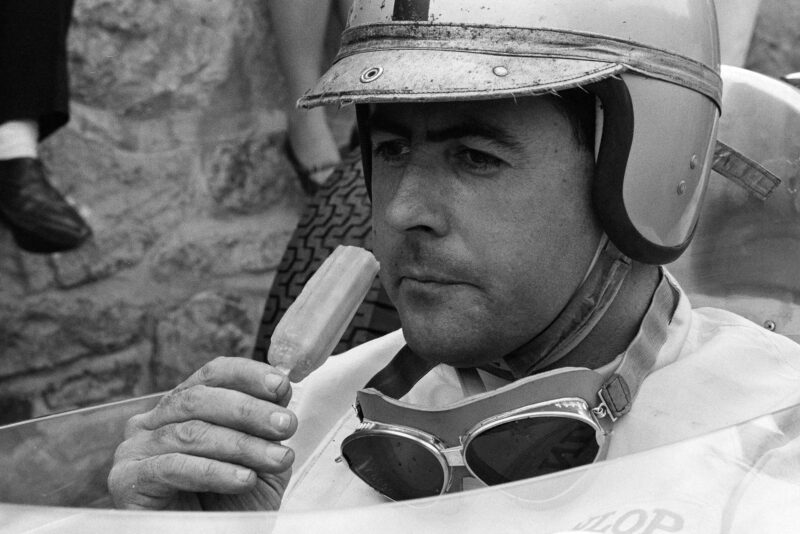
Brabham needed an ice-cool race approach after qualifying 15th
Motorsport Images
Then Mairesse went out and his best was 3min 59.8sec, but McLaren had been retrieved, refuelled, and was now in fine form and got in a best lap 3min 58.8sec, having done a number under 4min, and Ireland too was going well in the Climax V8-engined UDT car and also got under 4min, but he was not impressed with the Lotus 24 handling, and neither was Brabharn, who was going comparatively slowly.
After playing at racing-driver for a long time de Beaufort this year has been taking things much more seriously and his driving has improved enormously. His best time of 4min 7.7sec was faster than that recorded by Bonnier and Gurney last year in almost identical cars, while it was faster than Brabham and Trintignant with Climax V8-engined cars this year.
Gurney went slowly round in the white Lotus-BRM V8, taking it to 9,000rpm in top gear on one occasion and then deciding the car was not really race-worthy. Poor Jimmy Clark was having to stand around watching, with only 4min 09.2sec to his credit, which he did before his engine blew up, so just before practice ended his numbers were put on Taylor’s car and he did a few laps to try and improve his position, getting in a 4min 04.9sec without risking his team-mate’s engine; on the way back to the garage after practice the car became locked in two gears at the same time!
Practice had not been unduly exciting, but with six cars below 4min and four of those below last year’s fastest race-lap things looked fairly good, and there were three different makes on the front row of the grid. Ireland and Mairesse had made the same time so they tossed up to see who would go in the second row, and the Emeryson damaged its gearbox so Campbell-Jones arranged to borrow an old Lotus from a German friend.
Over Saturday night Clark’s Lotus was fitted with its new engine, Taylor’s car had one good gearbox built out of two, and Baghetti’s Ferrari was straightened out, but Gurney decided not to start the hurriedly-prepared Lotus-BRM V8. The works BRM of Hill had the low-level exhaust pipes put back on again and Coopers seemed quietly confident.
Race
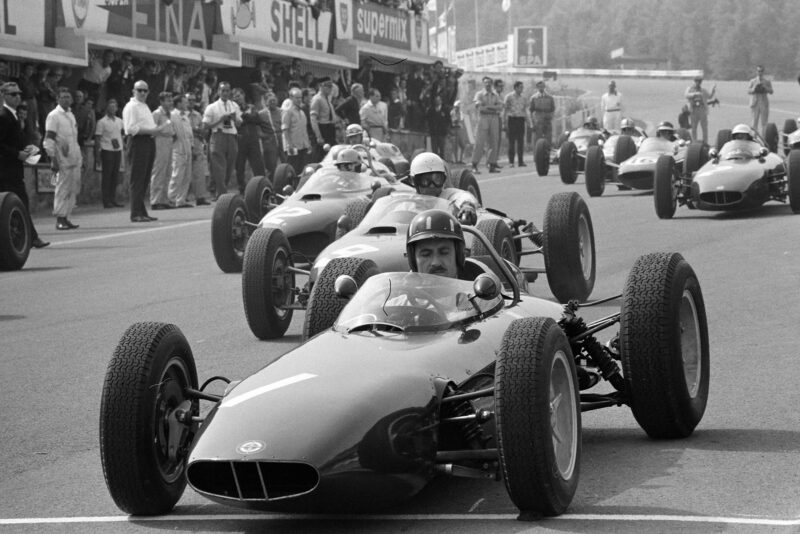
Hill started 1st on the grid
Motorsport Images
The Belgian Grand Prix is always impressive enough to stand on its own, without the need for a fiesta of dicing to lead up to it, so by 2:30pm on Sunday, under warm skies, the cars were fuelled and warmed up to get ready for the starting assembly. Team Lotus were still having troubles for the fuel-filler cap on Taylor’s car seized on its thread and efforts to move it broke the filler neck, so a spare tank had to be fitted in a rush; Ferrari were so conscious of the nonsense they made with Baghetti in practice that they fitted small security straps to the top of the engine cover, and Lola mechanics were squeezing the last half-gallon of petrol into the rubber fuel tanks of Surtees’ car, as it was to be a long race and fuel consumption was high on the V8 Climax engine. After the drivers had been driven for a whole lap in a parade in various open cars the racing cars were assembled on the grid and the drivers were gathered together and told to be good boys and not jump the flag.
It was a splendid start, all the engines were running by the 1min signal, the track was completely clear at 30sec, and everyone got away beautifully, the nineteen cars streaming down through the Eau Rouge bridge in a fine roar of noise and smoke. Up the steep climb the order was as in practice, Graham Hill, McLaren and Taylor, with Mairesse close behind.
“Everyone got away beautifully, the nineteen cars streaming down through the Eau Rouge bridge in a fine roar of noise and smoke”
At Malmedy McLaren was reported leading, but at Stavelot Graham Hill was back in the lead and, very tightly bunched on the first of the 32 laps, five cars braked heavily for the hairpin at La Source. Down past the pits the order was Graham Hill, Taylor, McLaren, Clark and Mairesse, all close enough for any of them to take the lead. Clark being so well placed bearing in mind his grid position was not only very good but a sign worth watching.
Following came Ireland, Phil Hill and Rodriguez in close combat and then a gap, and Maggs, Gregory, Surtees, Ginther and Brabham, followed a little later by de Beaufort heading the rest of the runners, all but Campbell-Jones who arrived late and stopped at his pit. From the confused and excited reports on the telephone system around the circuit it was obvious that a pretty good old dice was in progress, first one would take the lead and then somebody else, and the first five were still just as close when they braked for the hairpin at the end of lap two.
The order was Taylor, McLaren, Mairesse, Hill and Clark, the BRM seemingly beginning to slow and enter the pit area, but then going on again. These five had already left the rest behind, but Ireland was leading the two Ferraris, and Maggs was leading Surtees and Gregory, but Ginther and Brabham had dropped back and Baghetti was missing, only to appear long after everyone had gone by. He stopped at his pit and mechanics fiddled with the engine, and he then went on again.
Meanwhile the battle for the lead was continuing, and after the third lap Taylor was still leading, but they were all so close that there was continual passing and re-passing going on. Ireland was now behind the two Ferraris but still hanging on, and Surtees was leading the rest, but already quite a way back. At the end of lap four there were cheers from the great crowds for Mairesse was in the lead, and they went down the hill to the Eau Rouge in the order Mairesse, Taylor, McLaren, Hill and Clark; Ferrari, Lotus, Cooper, BRM, and Lotus, and there was still nothing in it, for they were all bunched together and lapping at over 130mph average, which must be Grand Prix racing, no matter how dull some drivers think it is.
Lap five and Taylor was back in the lead, lap six and seven and Mairesse was in front; this was no dull procession, on one lap Graham Hill would be fourth and the next he would be third, and then back into fourth again. The only consistent thing about this leading group was that Clark was continually in fifth place, so obviously sitting back and watching the others, at the same time learning the circuit at high speed for he had done very little practice. On lap eight the Clark plan was revealed for he moved up from fifth to second just like that, even though the others were still pushing and shoving.
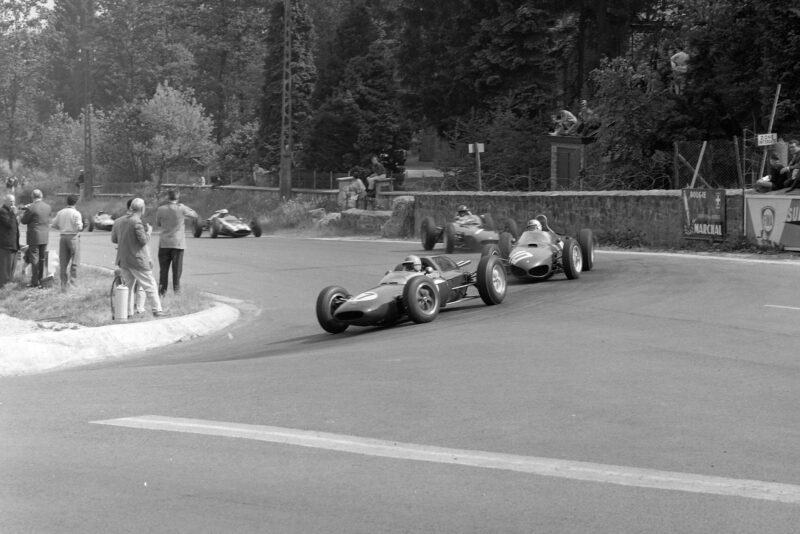
Taylor and Mairesse traded the lead over early laps
Motorsport Images
Hill was having a hard time for his injection system was not working properly when opening up or blipping the throttle to change down a gear, and on one lap Mairesse nipped by him on the inside at the hairpin and next lap McLaren dived by on the inside as they crossed the Eau Rouge bridge. In spite of this he was keeping well in the leading bunch. On lap nine Clark took the lead but still had Taylor, Mairesse, Hill and McLaren nose to tail behind him.
On lap 10 the Cooper and BRM had changed positions and Mairesse had the Ferrari alongside Taylor’s Lotus as they chased Clark down past the pits. This terrific battle almost overshadowed the rest of the field, from which Baghetti had withdrawn on lap four with ignition trouble and Ireland had stopped at his pit because the Lotus-Climax V8 was handling in a strange fashion. He did one more lap and stopped again, and this time it was found that a rear wishbone mounting was breaking away from the chassis. Mairesse had set fastest lap with 3min 57.4sec, but as the first five were all bunched together they were clearly all lapping in this time, and when he took the lead Clark was given 3min 57.0sec.
Team Lotus was now in a fine position, with their leader in first place and their other driver in second place, and the team of Clark/Taylor are very friendly and prepared to work together, so it was up to Trevor Taylor to drive foxily and hold back Mairesse, McLaren and Hill while Clark got away. Saying that and doing it are two very different things for Mairesse kept getting by, but Taylor always managed to retake the lead on the climb back from Stavelot and finish each lap in front of the Ferrari.
However, Clark was now really in his stride and put in a lap in 3min 56.9sec, following it with 3min 56.7sec, and with Hill’s BRM spluttering worse than ever the big dice was over. On lap 13 there were 10sec between Clark in first place and Hill in fifth place, which isn’t very much when they were all still lapping at over 130mph and there was no one else within striking distance. Phil Hill and Rodriguez were running in very close company, passing and re-passing rather needlessly it seemed, while Surtees stopped after thirteen laps as his fuel tanks were not venting properly.
The UDT-Laystall team had had a good look at Ireland’s car and decided to call in Gregory before his car’s chassis broke, and Brabham, who was not happy with his Lotus, was not trying and looked like being caught by de Beaufort. The Walker Team were in the unusual position of not being in the picture at all, Trintignant in the V8 being 13th, with an engine that was not running at its best, and Bianchi being at the back in the rather well-used 4-cylinder Lotus.
“The race average had climbed from just over 210kph to over 212kph, or almost equal to the average for the best lap last year”
On lap 15 Clark went round in 3min 55.6sec (average 215.449kph) and the race average had climbed from just over 210kph to over 212kph, or almost equal to the average for the best lap last year. At 16 laps, or half-distance, the order was Clark, Taylor, Mairesse, G Hill, McLaren, then a gap, and Rodriguez leading P Hill, both in Ferraris. A long way behind came Maggs, then another long gap and Ginther, and the remainder had been lapped, these being Surtees, delayed by a pit stop, Brabham who speeded up a little when he saw de Beaufort’s Porsche in his mirrors, de Beaufort, Trintignant, Siffert and Bianchi, with Campbell-Jones doing the odd lap here and there.
For a moment it looked as though everyone had settled down and that Taylor had fixed Mairesse, but on lap 18 the fiery Belgian renewed his attack and the passing and re-passing all round the circuit began again. Clark was a comfortable 10sec ahead of them and complete master of the situation, settling down to his own pace, but second place was very much in doubt for Mairesse had no intention of giving in and accepting third place. Graham Hill and McLaren were running fourth and fifth, close together but being nice about it until lap 20 when the Cooper lost all its oil pressure and McLaren switched off and drew into the side before the rods began to fly.
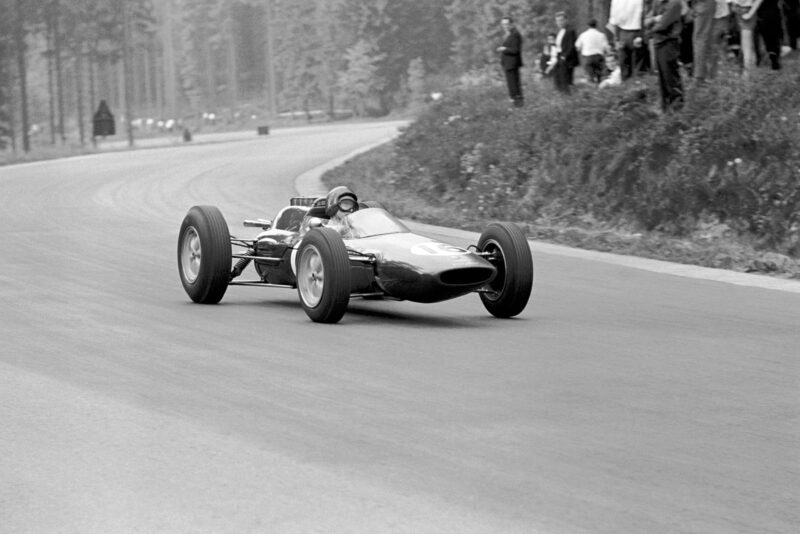
Clark was imperious once wresting the lead from team-mate Taylor on lap 9
Motorsport Images
Apart from the two Ferraris running fifth and sixth now, the remainder of the field was spread out, so all interest lay in the battle for second place. It seemed as if there was more at stake than just second place, for Taylor was preventing Mairesse getting at Clark, who was drawing away 2sec a lap. On lap 21 Mairesse was in second place, with Taylor hanging on grimly, and by the end of the next lap Clark had only gained 1sec, but then Taylor got past the Ferrari again. This was a pretty cut throat battle between these two, inexperience in one cockpit and exuberance in the other, and all at an average that was still over 130mph.
Taylor led on laps 24 and 25 but Mairesse had the Ferrari right there with him and there was nothing to choose between them, one driver brought up in the tough school of Formula Junior, the other in Rallies, now both a little out of their depth and fighting hard. On lap 26 it happened. Taylor was in the lead as they left the very fast left-hand bend at Blanchimont, just before the Club House and La Source, and at over 100mph the two cars touched. The Lotus cut down a telegraph pole and crashed into a ditch and the Ferrari caught fire and landed upside down. Fortunately both drivers were flung out, Taylor escaping with only a shaking and Mairesse needing first-aid for slight burns and numerous cuts and gashes.
While all this had been going on Maggs retired at the pits with a broken gearbox, Ginther retired at the far end of the circuit with gearbox trouble and no drive to the rear wheels, and Surtees had slowed down and given the OK to the Team Lotus pit, having seen Taylor standing by the wrecked cars. The race as such was now all over, Clark had only to tour home and win, after driving an incredibly intelligent and brilliant race, and Graham Hill in his spluttering BRM now found himself second, a stroke of luck to make up for his Monaco disappointment.
The two duelling Ferraris that had never had a look in while the race was at its height now found themselves racing for third place and this was in doubt right to the last corner, when Phil Hill forced his way by on the inside of the Mexican at the hairpin and led him down the hill and across the finishing line by a few inches. Surtees finished yet another Grande Epreuve with the Lola-Climax V8, which must encourage his team, and poor old Brabham was lapped twice by Clark in the “monocoque” Lotus 25 that outwardly looks like the same as you can buy but which is so different in performance; de Beaufort still had Brabham in sight at the finish, which says much for the way the big Dutchman has improved, and the two Walker cars and Siffert tailed in at the end.
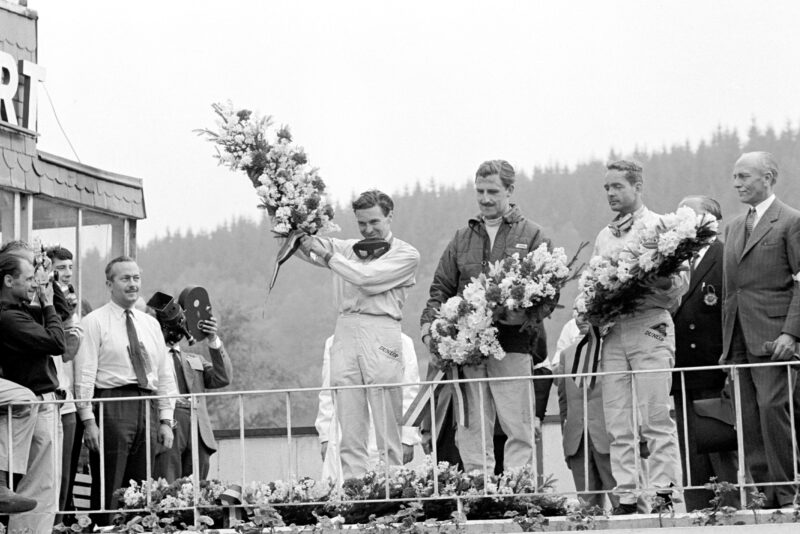
Clark celebrates his win on the podium
Motorsport Images
Spa spiels
- The first twelve laps were real Grand Prix racing, with no holds barred and an average speed of over 130mph.
- The Belgian Grand Prix was dignified in its organisation as a Grande Epreuve should be; one race, one winner, with the circuit unsullied by oil and rubber from minor events before the start.
- Zandvoort had National Sports Car races, Monte Carlo had Junior races, Silverstone and the BRDC had an orgy of speed and sport before the British Grand Prix in the past. Nice to see the BARC are restricting themselves to a brief GT race before Aintree.
- Are UDT-Laystall trying to do too much? They have BRM, Coventry-Climax, V8 and 4-cylinders, GT Ferrari V12 and 2.5-litre Climax engines to look after. Coopers find enough work just running in World Championship events.
- The two Team Lotus cars ran without tail cowlings as in practice they had measured the gearbox oil temperature. It made Porsche owners blanch and they are used to hot oil.
- The Francorchamps circuit had a truly international air, with the loudspeakers keeping the public in touch in French, Flemish, English and German.
- Willy Mairesse, the swarthy Belgian, is very popular with his countrymen but not so much with his fellow drivers; he is too much of a racer and a fighter, and it doesn’t help when he says “move over” in French and not in English!
